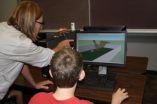(Press-News.org) When scientist David Valentine and colleagues published results of a study in early 2011 reporting that bacterial blooms had consumed almost all the deepwater methane plumes after the 2010 Gulf of Mexico Deepwater Horizon oil spill, some were skeptical.
How, they asked the University of California at Santa Barbara (UCSB) geochemist, could almost all the gas emitted disappear?
In new results published this week in the journal Proceedings of the National Academy of Sciences (PNAS), Valentine; Igor Mezic, a mechanical engineer at UCSB; and coauthors report that they used an innovative computer model to demonstrate the respective roles of underwater topography, currents and bacteria in the Gulf of Mexico.
This confluence led to the disappearance of methane and other chemicals that spewed from the well after it erupted on April 20, 2010.
The National Science Foundation (NSF) funded the research.
"As scientists continue to peel apart the layers of the Deepwater Horizon microbial story," said Don Rice, director of NSF's chemical oceanography program, "we're learning a great deal about how the ocean's biogeochemical system interacts with petroleum--every day, everywhere, twenty-four/seven. "
The results are an extension of a 2011 study, also funded by NSF, in which Valentine and other researchers explained the role of bacteria in consuming more than 200,000 metric tons of dissolved methane.
"It seemed that we were putting together a lot of pieces," Valentine said. "We would go out, take some samples, and study what was happening in those samples, both during and after the spill.
"There was a transition of the microorganisms and a transition of the biodegradation, and it became clear that we needed to incorporate the movement of the water."
The scientists believed that there was an important component of the physics of the water motion--of where the water went.
Valentine turned to Mezic, who had published results in 2011 forecasting where the oil slick would spread.
"Our work was on the side of: here's where the oil leaked and here's where it went," Mezic said. "We agreed that it would be beautiful if we could put a detailed hydrodynamic model together with a detailed bacterial model."
The resulting computer model has data on the chemical composition of hydrocarbons flowing into the Gulf of Mexico, and is seeded with 52 types of bacteria that consumed the hydrocarbons.
The physical characteristics were based on the U.S. Navy's model of the gulf's ocean currents and on observations of water movements immediately after the spill and for several months after it ended.
The scientists then sought the help of Mezic's former colleagues--engineers at the University of Rijeka in Croatia.
"We needed somebody to build the software," Mezic said. "It was a big task, a mad rush, but they did it.
"The power behind this is a tour de force. A typical study of this kind would take a year, at least. We found a way that led us to answers in three or four months."
The model revealed that one of the key factors in the disappearance of the hydrocarbon plumes was the physical structure of the Gulf of Mexico.
"It's the geography of the gulf," Valentine said. "It's almost like a box canyon. As you go northward, it comes to a head.
"As a result, it's not a river down there; it's more of a bay. And the spill happened in a fairly enclosed area, particularly at the depths where hydrocarbons were dissolving."
When the hydrocarbons were released from the well, bacteria bloomed. In other locations outside the gulf, those blooms would be swept away by prevailing ocean currents.
But in the Gulf of Mexico, they swirled around as if they were in a washing machine, and often circled back over the leaking well, sometimes two or three times.
"What we see is that some of the water that already had been exposed to hydrocarbons at the well and had experienced bacterial blooms, then came back over the well," Valentine said.
"So these waters already had a bacterial community in them, then they got a second input of hydrocarbons."
As the water came back over, he explained, the organisms that had already bloomed and eaten their preferred hydrocarbons immediately attacked and went after certain compounds.
Then they were fed a new influx of hydrocarbons.
"When you have these developed communities coming back over the wellhead, they consume the hydrocarbons much more quickly," Valentine said, "and the bacterial composition and hydrocarbon composition behaves differently. It changes at a different rate than when the waters were first exposed."
The model allowed the scientists to test this hypothesis and to look at some of the factors that had been measured: oxygen deficits and microbial community structure.
"What we found was very good agreement between the two," Valentine said.
"We have about a 70 percent success rate of hitting where those oxygen declines were. It means that not only is the physics model doing a good job of moving the water in the right place, but also that the biology and chemistry results are doing a good job, because you need those to get the oxygen declines. It's really a holistic view of what's going on."
There are valuable lessons to be learned from the study, the scientists believe.
"It tells us that the motion of the water is an important component in determining how rapidly different hydrocarbons are broken down," Valentine said. "It gives us concepts that we can now apply to other situations, if we understand the physics."
Mezic said that this should be a wake-up call for anyone thinking of drilling for oil.
"The general perspective is that we need to pay more attention to where the currents are flowing around the places where we have spills," he said.
"We don't have models for most of those. Why not mandate a model?
"This one worked--three-quarters of the predictions were correct. For almost everything, you can build a model. You build an airplane, you have a model. But you can drill without having a model. It's possible we can predict this. That's what a model is for."
INFORMATION:
The U.S. Department of Energy and the U.S. Office of Naval Research also supported the research.
In addition to Valentine and Mezic, co-authors of the paper are Senka Macesic, Nelida Crnjaric-Zic, and Stefan Ivic, of the University of Rijeka in Croatia; Patrick J. Hogan of the Naval Research Laboratory; Sophie Loire of the Department of Mechanical Engineering at UCSB; and Vladimir A. Fonoberov of Aimdyn, Inc. of Santa Barbara.
Gulf of Mexico topography played key role in bacterial consumption of Deepwater Horizon spill
Scientists document how geology, biology worked together after oil disaster
2012-01-10
ELSE PRESS RELEASES FROM THIS DATE:
Domain Name MacauCasino.com Now Available; Rare Domain Name in Booming Industry
2012-01-10
e21.com is thrilled to announce that the rare domain name MacauCasino.com is now available for purchase.
"Gaming is booming in Macau and there is no indication that it will slow down. On the contrary, Macau keeps on getting bigger and more profitable. Macau is already generating gaming revenues many times the size of Las Vegas and in the coming months I will surpass the entire United States,," said Paul Wilson, domain name expert.
"Some people prefer to spell it as Macau and some as Macao and both are correct. e21.com is happy to offer MacauCasino.com ...
Would you stop eating out to lose weight?
2012-01-10
Philadelphia, PA, January 10, 2012 – Going out to eat has become a major part of our culture. Frequently eating out and consuming high-calorie foods in large portions at restaurants can contribute to excess calorie intake and weight gain. However, a study in the January/February 2012 issue of the Journal of Nutrition Education and Behavior demonstrates that individuals can eat out and still lose weight.
Investigators from The University of Texas at Austin enrolled 35 healthy, perimenopausal women aged 40 to 59 years who eat out frequently. Participants took part in ...
Napa Technology Declares 2012 the Year of the Premium and Super Premium Experience
2012-01-10
Napa Technology, developer of the WineStation Intelligent Preservation and Dispensing System, aptly declared 2011 the year of wines by the glass. Now, Napa Technology is upgrading the declaration in 2012 with premium and super premium wines by the glass leading the trend. This year wines by the glass are finally breaking that ultimate wine glass ceiling; the reserve list. More commonly hospitality and retail environments are now offering the rarely uncorked premium and super premium wines by the taste, half glass and full glass with the help of wine preservation and dispensing ...
University of Utah, Google seek answers for autism
2012-01-10
These days, we hear a lot about the disorder of autism, but researchers at the University of Utah have created a program that helps kids with autism focus on building their skills and utilizing an aptitude for visual-spatial thinking, computers and other electronic media.
One of the program participants is 12-year-old Christopher Charles, who was diagnosed with what's now known as high-functioning autism when he was 18 months old. His parents started him in therapies early on, but hadn't found something that seemed to hold Christopher's interest or accommodate his behaviors.
Chris ...
Music Industry Expert, Avalon, Brings Controversy and New Interest to Major Music Trade Show
2012-01-10
Leading music industry expert, Moses Avalon, will be hosting three panels at the 2012 NAMM (National Association of Music Merchants) tradeshow in Anaheim, California on January 21st. Avalon's reputation for controversy and no holds barred honesty about the industry has boosted attendance at the trade show by attracting over 150 new members. NAMM organizers have invited Mr. Avalon to speak and lead three panels as part of H.O.T. Zone. H.O.T. Zone, a seminar within the tradeshow, provides live educational sessions and innovative ideas for professionals in the pro audio, entertainment ...
Online Exercise Equipment Store Offers New Year Gift Card Sweepstakes Worth $500 In Prizes To 11 Winners
2012-01-10
Everyone wants to be in shape and some are willing to take any risk to get that way. Some use crazy fad diets or diet pills, but there is no substitute for working out at a gym to shed those extra pounds. Until Now! Enter WorkoutHealthy.com's New Year Gift Card Sweepstakes for a chance to win a $300 or $20 gift card good towards home gym equipment. To enter the sweepstakes visit http://www.facebook.com/WorkoutHealthy?sk=app_184766258232400.
With every New Year people make resolutions to improve something about their selves. Why not make good on those resolutions this ...
ARIS Sport Reinvents the Wheel - Skateboard Carving Redesigned
2012-01-10
You've most likely have heard the jokes about reinventing the wheel, but now one company can seriously say that they did reinvent the wheel.
ARIS Sport has released a skateboard with their new wheel design. The new design is better for carving; curved wheels allow the skateboard deck to roll at extreme angles, allowing the rider to cut sharp right and left turns while maintaining balance and control of the skateboard even at low speeds.
The company has released a video of the design of the new skateboard, which you will find here: http://www.youtube.com/watch?v=wkJQdhkTJh0.
As ...
Graphene rips follow rules
2012-01-09
HOUSTON -- Research from Rice University and the University of California at Berkeley may give science and industry a new way to manipulate graphene, the wonder material expected to play a role in advanced electronic, mechanical and thermal applications.
When graphene – a one-atom thick sheet of carbon – rips under stress, it does so in a unique way that puzzled scientists who first observed the phenomenon. Instead of tearing randomly like a piece of paper would, it seeks the path of least resistance and creates new edges that give the material desirable qualities.
Because ...
Study finds air pollution linked to diabetes and hypertension in African-American women
2012-01-09
(Boston) -The incidence of type 2 diabetes and hypertension increases with cumulative levels of exposure to nitrogen oxides, according to a new study led by researchers from the Slone Epidemiology Center (SEC) at Boston University. The study, which appears online in the journal Circulation, was led by Patricia Coogan, D.Sc., associate professor of epidemiology at the Boston University School of Public Health and the SEC.
While it is well established that air pollution increases the risks of acute cardiovascular events such as stroke and myocardial infarction, it is not ...
Cell-CT: A new dimension in breast cancer research
2012-01-09
Despite advances in both the diagnosis and treatment of breast cancer, the disease remains a leading worldwide health concern.
Now, a new imaging technology under investigation at the Biodesign Institute at Arizona State University may help researchers pinpoint subtle aberrations in cell nuclear structure, the molecular biosignature of cancer, thus significantly improving diagnostic accuracy and prognosis by providing early detection of the disease.
The team, led by Professor Deirdre Meldrum, ASU Senior Scientist and Director of the Center for Biosignatures Discovery ...
LAST 30 PRESS RELEASES:
Safety decision-making for autonomous vehicles integrating passenger physiological states by fNIRS
Fires could emit more air pollution than previously estimated
A new way to map how cells choose their fate
Numbers in our sights affect how we perceive space
SIMJ announces global collaborative book project in commemoration of its 75th anniversary
Air pollution exposure and birth weight
Obstructive sleep apnea risk and mental health conditions among older adults
How talking slows eye movements behind the wheel
The Ceramic Society of Japan’s Oxoate Ceramics Research Association launches new international book project
Heart-brain connection: international study reveals the role of the vagus nerve in keeping the heart young
Researchers identify Rb1 as a predictive biomarker for a new therapeutic strategy in some breast cancers
Survey reveals ethical gaps slowing AI adoption in pediatric surgery
Stimulant ADHD medications work differently than thought
AI overestimates how smart people are, according to HSE economists
HSE researchers create genome-wide map of quadruplexes
Scientists boost cell "powerhouses" to burn more calories
Automatic label checking: The missing step in making reliable medical AI
Low daily alcohol intake linked to 50% heightened mouth cancer risk in India
American Meteorological Society announces Rick Spinrad as 2026 President-Elect
Biomass-based carbon capture spotlighted in newly released global climate webinar recording
Illuminating invisible nano pollutants: advanced bioimaging tracks the full journey of emerging nanoscale contaminants in living systems
How does age affect recovery from spinal cord injury?
Novel AI tool offers prognosis for patients with head and neck cancer
Fathers’ microplastic exposure tied to their children’s metabolic problems
Research validates laboratory model for studying high-grade serous ovarian cancer
SIR 2026 delivers transformative breakthroughs in minimally invasive medicine to improve patient care
Stem Cell Reports most downloaded papers of 2025 highlight the breadth and impact of stem cell research
Oxford-led study estimates NHS spends around 3% of its primary and secondary care budget on the health impacts of heat and cold in England
A researcher’s long quest leads to a smart composite breakthrough
Urban wild bees act as “microbial sensors” of city health.
[Press-News.org] Gulf of Mexico topography played key role in bacterial consumption of Deepwater Horizon spillScientists document how geology, biology worked together after oil disaster




